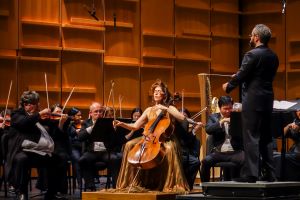First of all, a heartfelt thank you to the Greenville Utilities Commission for the repeated generous availability of parking for Sunday and evening events at the adjoining Music House.
Five powerful soloists from the North Carolina Baroque Orchestra united forces at the Music House to provide a concert of both solid and delightful music. They are harpsichordist Beverly Biggs, Frances Blaker on Baroque recorders, bassoonist Keith Collins, cellist Barbara Blaker-Krumdieck, and John B. O’Brien playing flute. In addition, this was a sneak preview of Ernie Miller’s new Andreas Ruckers single.
Because this program included two types of what is now called flute, some clarification is needed. One is the instrument known in the eighteenth century as flute/flûte/flauto, which we call recorder. The other, historically mostly known as traverso, is now called flute.
First on the program was Giovanni Battista Bassani’s Church Sinfonie, Opus 5, No. 3, played here on recorder, bassoon, cello, and harpsichord, using the Miller instrument. Bassani’s music is straightforward and robust, interpreted in that same way by the players, and especially well suited to the broad-shouldered vigor of the early Ruckers harpsichord building style. Miller’s instrument is authentic down to the printed papers lining the case and the soundboard painted by Sandra Shulinoff Miller. The cello had a real part, not just the basso continuo bass line, especially effective with a harpsichord such as this – sufficient on its own. The transition from the beginning Allegro into the Grave, played by a bassoon solo, was clever and effective.
Blaker-Krumdieck and Collins played a Largo and Allegro from Vivaldi’s Cello Sonata, Op. 14, No. 6/RV 46, as a duet. Collins played the bass line from the basso continuo without any keyboard accompaniment. There was lots of fun chromatic sliding around in the Allegro.
Michel Blavet’s Sonata No. 3 in E minor was performed by Blaker-Krumdieck, Biggs, and surprise guest artist O’Brien, who took the stage with several humorous asides, modestly deprecating himself and referring to someone in the audience as “a real flute player.” That’s okay by me. I consider O’Brien to be an “unreal” flute player – totally competent. His tone production on his one-key wooden flute by Rod Cameron is excellent. In spite of his modesty, O’Brien had achieved a nice mastery of “not my instrument.” The second movement, Largo poco andante, was rendered distinctive, in addition to the excellent playing, by the cello played pizzicato and the buff stop on the harpsichord, in this case the Music House French double by Richard Kingston.
Vivaldi’s Trio Sonata in A minor, RV 86, for recorder, bassoon, and basso continuo is typical of the diverse combinations of instruments for which Vivaldi wrote while teaching music at the Ospedale della Pietà in Venice; the institution included an orphanage for girls who were taught music by Vivaldi. The combination is unlikely, but the composition is musical, and the execution was excellent. The opening Largo, fast for a largo, had several interesting dialogues between instruments. The third movement, Largo cantabile, had a lot of repetitive phrases, like an exercise, but totally musical all the same. The final movement, Allegro molto, included some delightful fiery playing.
Vivaldi’s Sonata in B-flat for bassoon and basso continuo has some stylish writing and was very stylishly performed. Collins’ skill made the opening Allegro sound like a bel canto aria. The final Presto featured a careful juxtaposition of very smooth phrases and nice articulation.
The Recorder Sonata in A minor (originally for violin) by Francesco Maria Veracini is unusual in having a fifth movement – an opening Overtura. In spoken notes from the stage, Blaker suggested that Veracini (whose ambit was Florence-to-Venice) had heard a French overture and liked it, but couldn’t quite remember exactly what it ought to be. And that’s exactly what the Overtura sounds like, especially with the bassoon added to the basso continuo. The movement, labelled Paesana (Allegro), was full of amusing rustic doodle-doodle-dos, precisely executed. The concluding Giga: Postiglione was distinctively interpreted, especially in the contrast between louds and softs.
The concluding Quartet in A minor, TVW 43:a1 by Georg Philipp Telemann, is a big piece of chamber music, for recorder, traverso, bassoon, cello, and harpsichord. It was composed in Telemann’s usual big style and played equally big by the orchestra. The opening Andante was plaintive and piquant, especially because of the contrast between the sound of the traverso and the prominent odd-numbered harmonics of the recorder. The third movement, a Vivace labeled Divertimento 2, is filled with call and response, and was masterfully executed by all the players with the most infinitesimal spaces articulating each call and its associated response. The final movement, an Allegro labeled Divertimento 3, is in the strong 3-count rhythm of the gigue and was driven right along by the players.
This is a wonderful collection of some of the best from the North Carolina Baroque Orchestra. Their friendship, obvious from the audience, made a strong contribution to the cohesive playing heard last night. It also made for some interesting badinage with the audience. This was a charming evening of music at the very highest level of cooperation.











